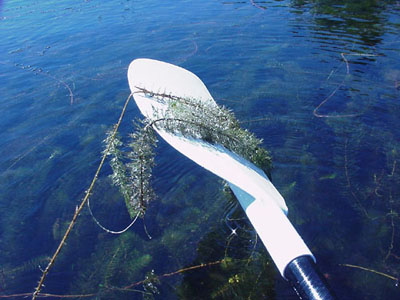

Milfoil photo courtesy of the Maine VLMP
What are invasive waterplants?
Invasive waterplants behave normally in their natural environment, but when they're introduced to new place (like a Maine lake) where they have no natural predators, they can grow unchecked. Without any natural enemies, they can take over a water body and make it unfit for human use.
Where do they come from?
Some invasive plants can grow from a seed or tiny fragment of plant carried on a boat or trailer that moves from an infested water body to a clean one. In most cases of waterplant infestation, bits of foliage have stuck to a boat or trailer and been carried to another location. There are established infestations in surrounding local lakes as well as in other states.
Some invasives are plants (or animals) that were used in aquariums and then carelessly dumped where they could get into a lake or stream.
Are they really a threat to Panther Pond?
Well, have a look at this map. The colored lakes and streams all have invasive plant infestations. Panther Pond is about halfway between the numbers 10 and 19. (Use the zoom tool; if you don't see it, you may have to right-click on the map to locate the zoom tools.) Look between 10 and 19. Panther Pond is directly under the word "Raymond." You'll see that lakes all around us are already infested.
Once an invasive colony is established, it's nearly impossible to eradicate it. (In the past 5 years, one small Maine pond has been successfully cleaned of invasives, but a new infestation has been discovered in another.) If a milfoil infestation is allowed to grow unchecked, for example, all the water shallower than about 15 - 20 feet can become so choked with weed that it's almost impossible to swim or get a boat through. If that's not a scary enough thought, you should know that property values can be drastically reduced by invasive plant growth in a water body.
How do you recognize an invasive plant?
The most common invasive waterplant in our area is variable leaf milfoil, but Maine also lists 10 other plants of concern. They come in all shapes and sizes, and some invasives are nearly indistinguishable from harmless native plants. In the case of milfoil, for instance, there are several native milfoils and several invasive versions, and it may even require genetic analysis to get a positive identification. What you can do is learn when to be suspicious. (See below under "What else can I do?")
What should I do if I see a suspicious plant?
DON'T try to remove it. Any broken fragments that escape may start more plants, and we need to check the surrounding area where the plant is growing. If you see a suspicious plant, mark it if possible. (An empty plastic bottle or piece of wood can serve as a temporary bouy, using a rock as an anchor. Try to make a note on the bouy: "Possible invasive plant. Please do not touch.") As soon as possible, please contact RWPA at (207) 831-7157 or lakes@raymondmaine.org; or contact VLMP at (207) 783-7733 or vlmp@mainevlmp.org. Describe the plant and its location; if possible, make yourself available to lead an inspector to the plant.
Please don't hesitate to sound the alert; better a hundred false alarms than one invasive missed.
How do I know if there's an invasive plant on my boat or trailer?
A plant fragment so small that you don't even see it can cause a new infestation; the more eyes the better. If you meet a courtesy inspector at the boat ramp, please cooperate to check your equipment. These people are trained to look for invasive plants, and to help you learn how to inspect your own gear.
Check your boat & trailer before every launch. If you see ANY bits of plant material on your boat or trailer, remove them and deposit them well away from the water, where they can't be carried into the lake by rainwater, animals, or other vehicles. Also, please inspect your boat when you leave a lake, especially an infested one, so you don't unwittingly carry plants to other places.
Please note: invasive plant fragments can also hitch a ride on boots and waders, fishing tackle, anchors and lines, live wells, sumps and bilges, scuba and snorkeling gear, etc.
What else can I do?
Learn to identify the dangerous plants. The Maine Center for Invasive Aquatic Plants teaches courses in plant identification. The classes are fun as well as useful, and you meet the nicest people! Check with MCIAP or RWPA for the next scheduled plant identification workshop in your area. We're always in need of more certified plant patrollers to do annual surveys of the lakes, looking for invasive plants.
The MCIAP has published a superb Maine Field Guide to Invasive Aquatic Plants to help you identify invasives. (Click HERE.) Every boat owner and lake property owner should have a copy. (Better yet - take a class in invasive-waterplant identification from VLMP; the class is free, and you get the book free, too.)
Click here for a quick guide to identifying many common water plants (it's not complete, but it can give you a good start.)
